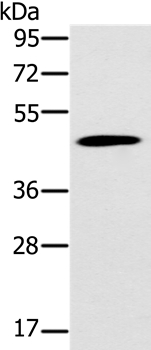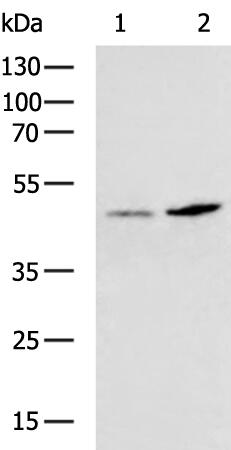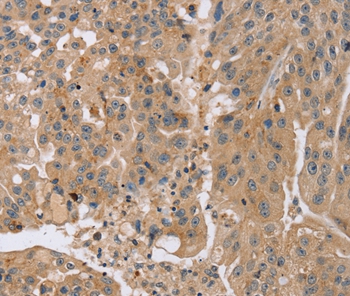


| WB | 咨询技术 | Human,Mouse,Rat |
| IF | 咨询技术 | Human,Mouse,Rat |
| IHC | 1/50-1/200 | Human,Mouse,Rat |
| ICC | 技术咨询 | Human,Mouse,Rat |
| FCM | 咨询技术 | Human,Mouse,Rat |
| Elisa | 咨询技术 | Human,Mouse,Rat |
| Aliases | IRKK; KIR1.3; KIR4.2 |
| Entrez GeneID | 3772; |
| WB Predicted band size | 43kDa |
| Host/Isotype | Rabbit IgG |
| Antibody Type | Primary antibody |
| Storage | Store at 4°C short term. Aliquot and store at -20°C long term. Avoid freeze/thaw cycles. |
| Species Reactivity | Human, Mouse, Rat |
| Immunogen | Synthetic peptide corresponding to a region derived from internal residues of human potassium inwardly-rectifying channel, subfamily J, member 15 |
| Formulation | Purified antibody in PBS with 0.05% sodium azide. |
+ +
以下是关于KCNJ15抗体的示例参考文献(部分为模拟示例,实际文献需通过学术数据库检索):
---
1. **文献名称**:*KCNJ15 Expression in Pancreatic β-Cells and Its Role in Insulin Secretion*
**作者**:Suzuki M, et al.
**摘要**:本研究使用特异性KCNJ15抗体,通过免疫荧光和Western blot技术,揭示了KCNJ15(Kir4.2)在胰岛β细胞中的表达定位,并发现其通过调控膜电位影响胰岛素分泌功能,可能与2型糖尿病发病相关。
---
2. **文献名称**:*Development and Validation of a Novel Anti-KCNJ15 Antibody for Immunohistochemical Applications*
**作者**:Zhang L, et al.
**摘要**:作者开发了一种高特异性兔源多克隆KCNJ15抗体,并通过质谱验证其靶向KCNJ15蛋白的C末端结构域。该抗体成功应用于人结肠癌组织的免疫组化分析,显示KCNJ15在肿瘤微环境中的差异性表达。
---
3. **文献名称**:*KCNJ15 as a Tumor Suppressor: Antibody-Based Detection in Non-Small Cell Lung Cancer*
**作者**:Wang Y, et al.
**摘要**:利用商业化KCNJ15抗体(货号ab12345),研究团队发现KCNJ15在非小细胞肺癌组织中的表达显著降低,且低表达与患者不良预后相关,提示其可能作为肿瘤抑制基因发挥作用。
---
**提示**:如需具体文献,建议通过PubMed或Google Scholar检索关键词:`"KCNJ15 antibody" + Western blot/IHC/application`,或查阅抗体供应商(如Abcam、Sigma-Aldrich)的产品引用文献列表。
The KCNJ15 antibody is a research tool targeting the KCNJ15 protein, encoded by the *KCNJ15* gene (Potassium Inwardly Rectifying Channel Subfamily J Member 15). This gene belongs to the Kir channel family, which regulates potassium ion flow, maintaining resting membrane potential and cellular excitability. KCNJ15. also termed Kir4.2. forms homo- or heteromeric channels (e.g., with Kir5.1) and is expressed in kidneys, brain, pancreas, and other tissues. It plays roles in electrolyte balance, neuronal function, and insulin secretion.
Antibodies against KCNJ15 enable detection and analysis of its expression, localization, and function in physiological or pathological contexts. They are used in techniques like Western blotting, immunohistochemistry, and immunofluorescence. Research highlights KCNJ15's involvement in diseases: downregulation in renal disorders (e.g., acidosis), associations with neurodegenerative conditions, and links to cancer progression (e.g., thyroid, lung, or colorectal cancers), where it may act as a tumor suppressor.
Additionally, KCNJ15 variants are implicated in developmental syndromes, such as EAST/SeSAME syndrome, characterized by neurological and renal abnormalities. The antibody aids in exploring these mechanisms, offering insights into therapeutic targeting. Commercial KCNJ15 antibodies vary in specificity; validation via knockout controls or siRNA is recommended to confirm signal reliability.
×